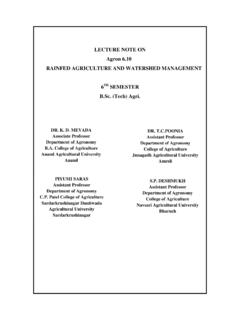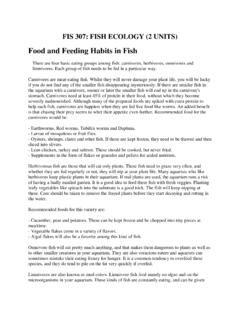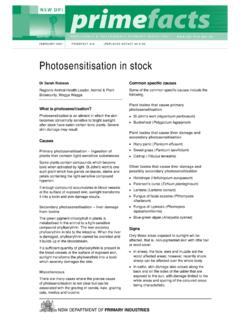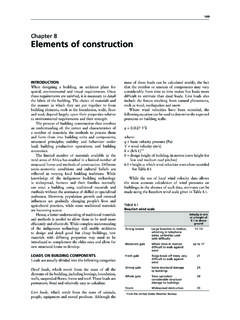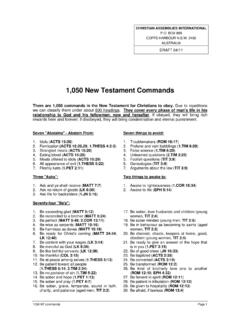Transcription of EXERCISE-1 STUDY OF EXTERNAL ANATOMY/BODY PARTS OF …
1 1 EXERCISE-1 STUDY OF EXTERNAL ANATOMY/BODY PARTS OF CATTLE, BUFFALO, sheep AND GOAT Objectives: A person working with animals should have proper knowledge of the different PARTS of the animal body for the following reasons: 1. To judge the utility of animal. Degree of development of certain PARTS of the animal body has relationship with the usefulness of the animal size of the udder and milk production in lactating animals, development of legs and ability to work in working bullocks etc. 2. The knowledge of EXTERNAL anatomy or body PARTS is essential for classification/recognition/registration of breed of animal.
2 3. For giving exact information and communication at the time of sickness, injury, theft, sale and purchase of animal etc. 4. To know about the sex as well as the general health/sickness of the animal. 5. The student must be acquainted with different terminologies of animal body PARTS . For the convenience and ease of understanding the body PARTS , the cattle/animal s body is arbitrarily divided into five regions, viz. (A) Head (B) Neck (C) Body or Barrel (D) Fore limbs or Fore quarters and (E) Hind limbs or Hind quarters. The EXTERNAL Body PARTS of a Cow: (A) Head : 1. Mouth : Lips, tongue, teeth, jaw and dental pad, organ of prehension.
3 2. Horn : Generally black in young age and yellowish black in old age. In some breeds they are pinkish yellow. The rings are present on horn. (A) Tip of the horn (B) Base of the horn. 3. Head crest : The portion between the bases of horns. 4. Fore head : The portion situated below the head crest and above the level of two eyes. It is flat, dishy or bulging in shape. 5. Face : It is the portion below the level of two eyes up to the muzzle. 6. Poll : It is the bulging portion situated at the middle top centre of the fore-head. 7. Cheeks : Lateral portion of the face below the eyes on both the side.
4 8. Chin : Portion below the lower lip. It is fleshy and pink in colour. 9. Muzzle : The projecting part of the head including the mouth, nose and jaws. 2 10. Muffle : Fleshy bare part of the upper lip and nose. Generally it is black. In some breeds it may be pinkish or spotted. It is wet with droplets of water in healthy animals. It has specified line and marking into muzzle print. 11. Nose : It has two nostrils. 12. Eye : Eye brows, eye lids, eye lashes and eye ball. 13. Ear : Tip of the ear, fringe of the ear and base of the ear. They are erect to pendulous in shape. EXTERNAL Body PARTS of Cattle 3 EXTERNAL Body PARTS of sheep EXTERNAL Body PARTS of Goat 4 (B) Neck : 1.
5 Neck crest : It is the upper portion of the neck between head crest and hump/points of withers. It is the portion where yoke is placed in bullocks. 2. Dewlap : A hanging loose, wavy fold of skin between chin and brisket. It is more developed in tropical breeds of cattle and helps in heat dissipation. European cattle possess less developed dewlap. 3. Brisket : A fleshy bulging mass between and in front of the fore limbs. 4. Jugular groove : A groove running down the neck above the wind pipe. (C) Body or Barrel : 1. Hump : The bulging fleshy mass between neck crest and back.
6 2. Point of withers : Point just behind the hump located between the two shoulder blades. 3. Back : Portion between point of withers and the last ribs. 4. Loins : The triangle formed by joining the head of last ribs to the two hook bone. 5. Sacrum : Portion from middle point of two hook bone and ending near the croup or root of tail. 6. Rump : Sloppy/encircling portion on either side of the croup between the hook bone and pin bone. 7. Hook-bone : It is the prominent bone on either side of the root of tail (tuber ischii). 8. Pin bone : It is also the prominent bone on either side of the root of tail (tuber ischii).
7 9. Tail : A distinct flexible appendage extending from the rear end of the animal s body. 10. Switch : Bunch/tuft of hair at the end of the tail. 11. Chest : Portion between two fore limbs just behind the point of elbow. 12. Heart girth : The circular measurement around chest. 13. Ribs : Thirteen pairs. 14. Hollow of the flank : The depression of the abdominal cavity between last rib and hook-bone which is triangular in shape. 15. Flap of the flank : Thick skin hanging between hind limb and abdomen. 16. Navel : Point on the lower side of the belly, left by dropping off the navel cord through which embryo receives nutrition and oxygen from the mother and gives off the waste products.
8 5 17. Udder : Structure containing mammary glands of cows. It has four quarters each having one separate teat. Degree of development of udder generally shows the capacity for production of milk. The teats are well placed at equal distance, shows even development of udder. 18. Milk vein : Situated on either side of abdomen between udder and milk well. It is zigzag and carried impure blood from the udder to the heart. 19. Milk well : It is point on either side of the chest where the milk vein enters into the body cavity. 20. Milk mirror : The bare yellowish portion extending from below the vulva up to the udder.
9 21. Anus : Posterior opening of the alimentary canal. 22. Vulva : EXTERNAL female uro-genital organ reflect that female is in heat or not. 23. Supernumerary teats : Extra teats which are non-functional. They may be removed. (D) Fore Quarters : 1. Shoulders : Portion between the points of withers and point of shoulder. 2. Point of shoulder : It is a prominent joint of shoulder situated between point of withers and the elbow joint. 3. Arm : Portion between point of shoulder and point of elbow. 4. Fore arm : Portion between elbow joint and knee joint. 5. Knee joint : Joint between fore arm and shank.
10 6. Cannon : The portion between knee joint and fetlock joint. 7. Fetlock : Joint between the shank and pastern. 8. Pastern : Round portion between the fetlock joint and coronet. 9. Coronet : Hairy streak just above the hoof. 10. Hoof : It has two digits, black in colour in case of cow and buffaloes. The space between the two digits is known as interdigital space. 11. Dewclaw : Rudimentary hoof, two in number on each leg. (E) Hind Quarters/Limbs : 1. Point of hip or hook bone : The EXTERNAL angle of ileum occurs as a bony prominent on either side of loin. 2. Hip joint : The prominence formed over the hip joint by the greater trochanter of the femur.

